| |
In 1989, Six Flags Great Adventure announced an
agreement to build a minor league baseball stadium on the park property.
The stadium was to be the first new minor league stadium in New Jersey,
predating the proliferation of stadiums that have been built around the
state since then.
|
|
|
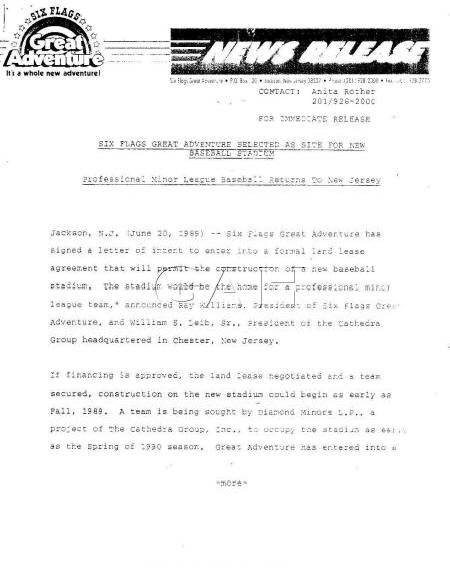 |
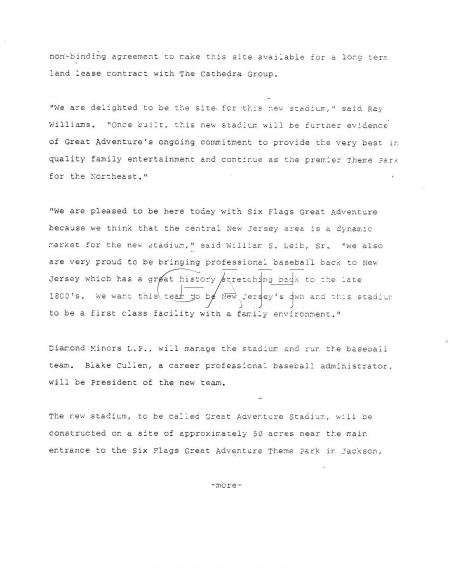 |
|
Press Release Issued By Six Flags Great Adventure |
 |
 |
|
|
On Thursday, June 15, 1989, the top story in the Asbury Park Press
leaked the news that Six Flags Great Adventure would be making a major
announcement within days,
outlining plans for a minor league baseball stadium and adjoining hotel.
According to the article, sources said the stadium would occupy a 50
acre site on the park property, and would initially have seating for
40,000, with the potential to expand to 60 or 80 thousand seats in
following years as crowds demanded. It would turn out the
scope of the project was greatly exaggerated by the article's source.
The park's press conference laid out the plans in more detail and
cleared up the misconceptions.
|
 |
 |
The site proposed for the stadium was just off Route 537 and the
existing park entrance road. This site would eventually
become home to the Hurricane Harbor waterpark.
The ballpark was to be called "Great Adventure Stadium" and was to be
built on park property by the Cathedra Group's subsidiary, Diamond
Minors L.P., a Morris County based company that was looking to bring a
minor league team to New Jersey. The land was to be
leased by the park for 50 years, with the Cathedra Group footing the
costs and running the stadium as well as purchasing and relocating a
team.
The plans called for construction to take 6-8 months and be ready for
the 1990 baseball season. The size of the stadium was 5,500 seats,
with plans for expansion to 8,500 seats in the second season, and an
eventual build out to 20,000 seats. The stadium also was to
have 10 sky boxes, and a parking area that could hold up to 3,000 cars.
Projected cost of construction for the initial phase of the project was
$6 million.
|
Total costs for the project including construction
of the stadium, purchasing and moving a team, and the additional startup
and advertising costs were projected to be around $12 million.
Cathedra Group was in the market for a "AAA" or "AA" league team, and
speculation was that the Oklahoma City '89ers or the
Williamsport Bills were top contenders for purchase.
The stadium was scheduled to employ about 20 full time workers, and have
additional part time staff during the season. Tickets
were supposed to be $5-$6 each, and all seats were to have completely
unobstructed views and be less than 100 feet from the field.
Games were expected to normally draw 4500-5000 people, but with crowds
as little as 2500 per game, the team could break even on costs.
The site was chosen for its proximity to major population centers in the
state and its central location near major highways. Studies
at the time said 2.1 million people were living within a 1/2 hour drive
of the stadium.
|
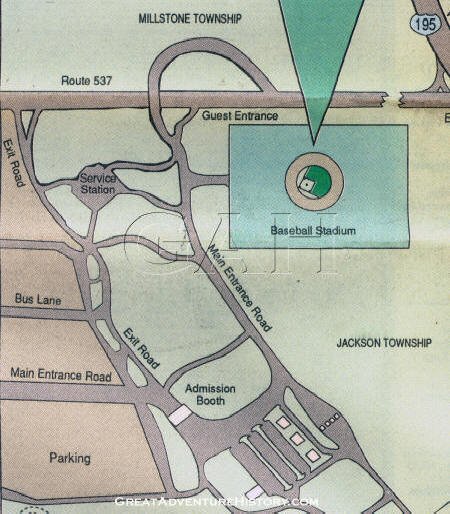 |
 |
The stadium was to be built of steel and precast concrete components for
cost effective and rapid construction. The field was to be
real grass bucking the trend of Astroturf which was still popular for
stadiums at the time.
In addition to being home to a minor league team, the stadium was also
going to be available for Little League, High School and College
tournaments and other special events.
|
Beer sales were to be restricted to the 10 sky boxes only, in an attempt
to maintain a family friendly atmosphere. At the time, the
park had also restricted beer sales to special events as they focused on
improving their family image.
According to then Park President Ray Williams, "The Stadium fits in with
Six Flag's plans to make Great Adventure the largest recreational
complex in the country". He also mentioned that while a hotel was
not planned in this phase, as the increased crowds warranted long range
plans called for construction of a hotel on the park property.
|
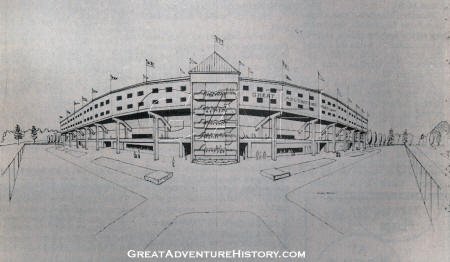 |
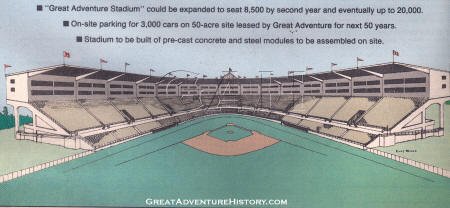 |
Part of the news conference focused on the history of baseball in New
Jersey, with the first known baseball game ever being played in Hoboken.
The last of the professional baseball teams that called New Jersey home
had moved out of the state in 1978, and Cathedra Group believed there
was a market for a new team.
The plans never made it off the drawing board for Great Adventure
Stadium, but baseball ended up coming back to New Jersey in the
following years, with 8 minor league stadiums built since then: |
| New Jersey Minor League
Stadiums Built Since 1990 |
| Stadium Name |
Location |
Capacity |
| Campbell's Field |
Camden |
6425 |
| First Energy Park |
Lakewood |
6588 |
| Commerce Bank Park |
Bridgewater |
6700 |
| Waterfront Park |
Trenton |
6500 |
| Riverfront Park |
Newark |
6000 |
| Bernie Robbins Stadium |
Atlantic City |
5500 |
| Skylands Park |
Augusta |
4800 |
| Yogi Berra Stadium |
Little Falls |
7100 |

|
|
|













